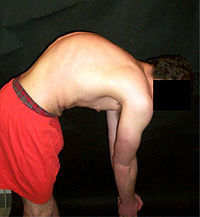
Photo from wikipedia
Study Design: This is a retrospective analysis of kinematic magnetic resonance images (kMRI). Objective: To assess the association of cervical paraspinal muscle with cervical sagittal balance and degenerative spinal disorders.… Click to show full abstract
Study Design: This is a retrospective analysis of kinematic magnetic resonance images (kMRI). Objective: To assess the association of cervical paraspinal muscle with cervical sagittal balance and degenerative spinal disorders. Summary of Background Data: Although the effects of spinal disorders and cervical imbalance on patient’s symptoms have been well described, the relationship of the cervical muscle quality and volume to cervical imbalance or spinal disorders is not well established. Materials and Methods: In total, 100 kMRI taken in a neutral weight-bearing position were analyzed. The adjusted cross-sectional area ratio (aCSA ratio: the value of muscle CSA divided by the vertebral CSA) and fat infiltration ratio of the transversospinalis muscles at C4 and C7 vertebral levels were measured using axial slice of kMRI. The correlation with cervical balance parameters [Oc–C2 angle, C2–C7 angle, C7–T1 angle, C7 slope, T1 slope, cranial tilt, cervical tilt, thoracic inlet angle (TIA), and neck tilt] and cervical degenerative disorders (disk degeneration, Modic change, and spondylolisthesis) were evaluated. Results: The aCSA ratio at C4 correlated with C2–C7 angle (r=0.267), C7 slope (r=0.207), T1 slope (r=0.221), disk degeneration at C3–4, C4–5, C5–6 (r=−0.234, −0.313, −0.262) and spondylolisthesis at C3 (anterior: r=−0.206, posterior: r=−0.249). The aCSA ratio at C7 correlated with disk degeneration at C3–4, C4–5, C5–6, C6–7 (r=−0.209, −0.294, −0.239, −0.209). The fat infiltration ratio at C4 correlated with TIA (r=0.306) and neck tilt (r=0.353), likewise the ratio at C7 correlated with TIA (r=0.270) and neck tilt (r=0.405). All correlations above were statistically significant with P<0.05. Conclusions: The paraspinal muscle volume showed significant relationship with the cervical balance parameters and disk degeneration. While, paraspinal muscle quality related to the thoracic inlet parameters. Our findings can be an important step to develop the knowledge of the association between cervical muscle and cervical degenerative disorders, as well as the sagittal balance of the cervical spine. Level of Evidence: Level III.
Journal Title: Clinical Spine Surgery
Year Published: 2019
Link to full text (if available)
Share on Social Media: Sign Up to like & get
recommendations!